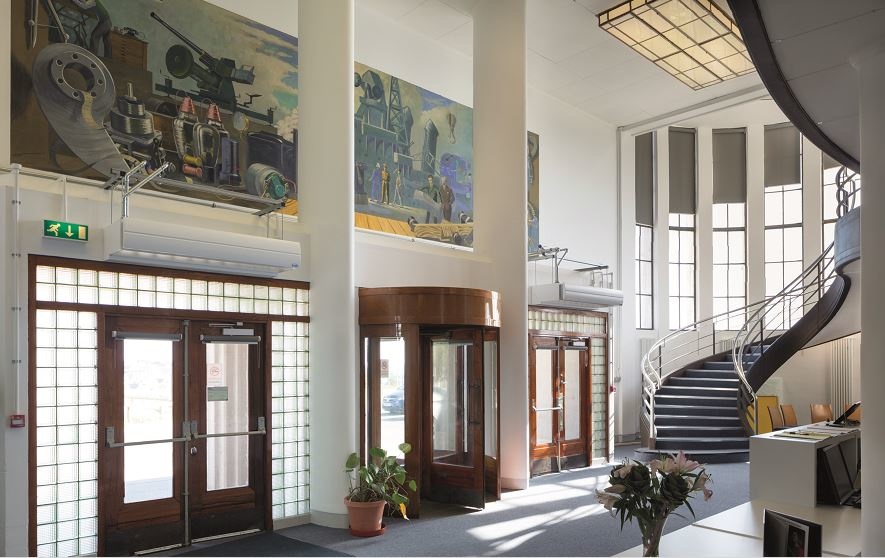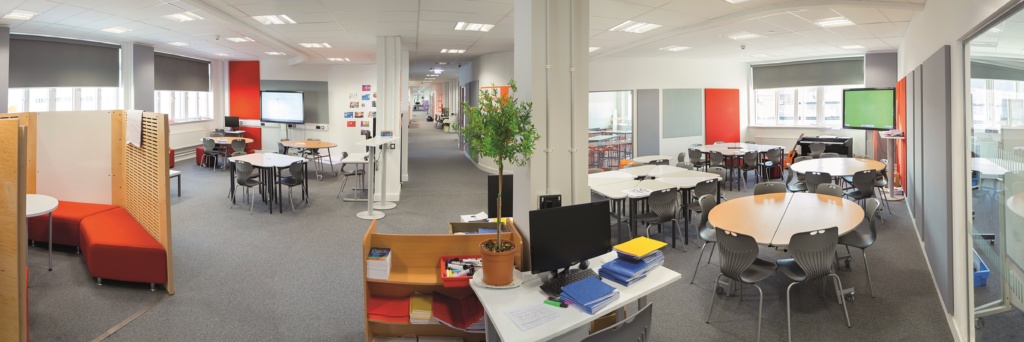
The Year 5/6 Learning Zone on Portland, in Dorset, England, is a suite of complementary and connected learning spaces designed to meet the needs of students for 21st century learning and for staff to work more collaboratively in learning teams in order to achieve the Academy’s unique vision for learning. Here, Terry White, who was what he refers to as the ‘learning-led’ Design Advisor for the project (and is also a UK Director of A4LE) outlines the process they employed and shares the results.
Portland is an all-through academy: it’d be referred to as a K-12 school in America – a single institution catering for learners throughout their whole formal education without the need to change from junior to senior schools. Located on the Isle of Portland, it was formed from the amalgamation of the island’s secondary school with five of the primary schools, who have relocated into a refurbished and reconfigured former Ministry of Defence building known as Maritime House, situated on an SSSI (Site of Special Scientific Interest) in a mixed-use development that includes housing and an adjacent hotel. The design includes features detailed to support and encourage learners in developing and maturing their learning skills as they prepare for the next phase of their education. Fundamental to the pedagogy, organisation and design of the learning spaces, was the importance of:
- students being better known and supported - throughout their learning lives,
- making their learning personal - minimising the limits on their progress
- using an enquiry and project based approach
- embedding as much learning science as possible into the design.
The Big Picture

Through consultation and engagement with a wide range of stakeholders including local headteachers, parents as well as the wider community and over a period of several years a vision started to evolve that sought to encourage all students to achieve success and be fully engaged in their learning. Stakeholders wanted to make all learning on Portland outstanding and to create an exceptional, world class school. There was widespread agreement that the existing system of education was not working for the young people of Portland and ’more of the same’ was not an option for the new academy.
Central to this vision is the provision of continuous learning from ages 3-19 in an inclusive, nurturing, ambitious and secure school environment. The new learning environments, therefore, needed to be designed to offer consistency in teaching, learning, care and support, throughout the students’ learning experiences at the academy. It is recognised, and research in the UK consistently confirms, that for many students there is a “dip” in learning outcomes on transfer from the Primary to Secondary phase and a new organisational structure needed to be in place to remove the ‘artificial divide’ and lack of continuity and progression that occurs. This approach was also seen as critical in improving the collective understanding and professional knowledge of teaching and support staff about the key approaches to teaching and learning required at each stage of a student’s school career.
A further key consideration of the initial planning group was that research was starting to indicate that larger schools should be broken down into smaller learning communities where students could be better known and supported throughout their time within a school. For example, a survey commissioned by Teach First, a UK social enterprise charity, entitled “Lessons from the Front”, had already established concern that schools should be divided into smaller learning communities to overcome the depersonalising tendencies of traditional structures. The report concluded that, “small learning communities would ensure that every pupil was known as an individual, making it harder for pupils to fall under the radar”. As far back as 1999 the educational resources Information centre (ERIC) was summarising a swathe of research as thus: “A great deal of research suggests that smaller schools contribute to student achievement, attainment, and sense of well-being… To capture some of the benefits of small-scale schooling, educators are increasingly looking for ways to downsize, including dividing large schools into subschools or subunits.”